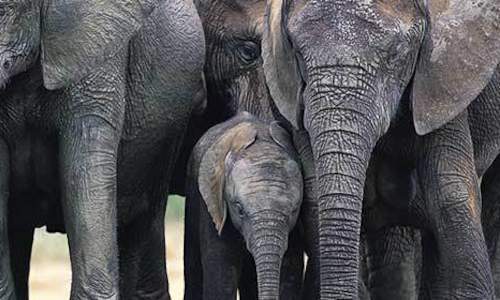
- In September 2005, South African minister of environmental affairs and tourism, Marthinus van Schalkwyk, announced that the cabinet has given him a mandate to develop Norms and Standards for Elephant Management. This followed a submission by the South African National Parks (SANParks), which recommended that:
- In order to maintain biodiversity in national parks, elephant populations should be controlled in some areas and left to fluctuate naturally in other zones of the parks;
- Guidelines should be developed to help parks decide when population control is needed, and what measures are best for that specific location; o Population control measures (such as capture, translocation, contraception or culling) should be overseen by an animal ethics committee; and o Where culling was necessary, animal products should for utilised to the benefit of local communities.
- A task team consisting from representatives of the department of environmental affairs and tourism (deat) and Eastern Cape, KwaZulu-Natal, Mpumalanga, Northern Cape and Northwest provinces, along with various specialists, was appointed to guide the process.
- During the policy formation stage in 2006, the minister and senior department officials hosted a series of formal and informal engagements with NGOs and scientists in South Africa, Kenya, Namibia, the US, UK and Europe. A significant body of knowledge was sourced for review by the task team.
Among the key concept explored at this stage of the consultation process were the impacts of elephants on biodiversity, the meaning of 'the precautionary principle' in the context of conservation management and the social acceptability of 'sustainable utilisation of natural resources'.
- A Science Round Table (SRT), consisting of 18 internationally recognised elephant scientists, was convened to provide the minister with a consensus view. This turned out to be a tremendous challenge and resulted in recognition that further research was necessary. The SRT put forward a research proposal and the Department agreed to a contribution of R5 million.
Under the guidance of the Council for Scientific and Industrial Research (CSIR), thirty leading scientists, philosophers, economists, animal rights experts and lawyers recently published a 12-chapter document, 'The 2007 South African Assessment of Elephant Management'. This will form the basis of a long-term research programme based on the concept of 'adaptive management' or 'learning-by-doing'.
- In February 2006, the department published the Norms and Standards in the Government Gazette, allowing a 60 days commentary period. Eighty formal submissions (many running to more than 50 pages) were received in addition to 36 inputs by way of petitions or letters.
- It was eventually decided that issues relating to the management of elephants in captivity would be dealt with as minimum standards in the ENS, while the department of agriculture and land affairs would be invited to develop norms (or a code of conduct) dealing with the training and ethical treatment of elephants. The ENS therefore provides for the minster to develop minimum standards within 12 months. A joint task team from the two departments will manage this process as a priority.
- The MINMEC: Environment was consulted at various junctions as policy options emerged, with the final interaction and approval on February 7, 2008.
- On February 25, 2008, the minister announced that the Norms and Standards for the Management of Elephants in South Africa would be published in the Government Gazette on February 29, 2008 and become effective on May 1, 2008 (Source: www.deat.co.za)
Mabunda Welcomes Announcement of Elephant Norms and Standards
The chief executive of South African National Parks (SANParks), Dr David Mabunda, announced on February 25, that SANParks welcomesthe minister of environmental affairs and tourism, Marthinus van Schalkwyk, announcement of the Norms and Standards for the Management of Elephants in national parks and other protected areas.
In February 2005 SANParks presented the minister with a proposal for the management of elephant populations in national parks, after much consultation with various stakeholders through The Great Elephant Indaba of 2004 and other events for a proposal that included park expansion, translocation, contraception and culling. The inclusion of culling as a management tool sparked some heated debate from mainly animal rights groupings, which has been going on since.'The approval through the Norms and Standards for the full suite of management interventions means that SANParks will be able to draw on the most appropriate management interventions for prevailing circumstances', said Dr Mabunda. 'We want to also make it clear that the decision to use different management tools will not be made indiscriminately. Even a decision to cull is one that is to be made prudently in line with appropriate management decisions.'
'Considering that management objectives and circumstances vary from park to park decisions on management interventions will differ accordingly. In the extreme cases, where culling may be considered as a management option, we will be guided by the provisions of the park management plans. Because there has been no culling in all national parks since 1995, the decision to go ahead with culling will take time as sufficient time and consultation is necessary to prepare for such an operation, should the need arise.'

 In and around Kruger National Park (KNP), the issue of elephant management is highly debated, as some scientists argue that there are too ma...
In and around Kruger National Park (KNP), the issue of elephant management is highly debated, as some scientists argue that there are too ma...